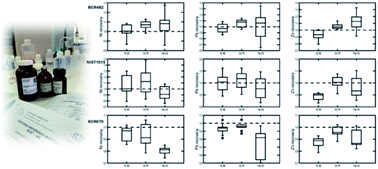Influence of an internal standard in axial ICP OES analysis of trace elements in plant materials
Abstract
Internal standardization is a commonly used approach to deal with the problems posed by non-spectral interferences in inductively coupled plasma optical emission spectrometry (ICP OES). However, in many real cases, the application to routine analysis, e.g. of environmental samples, is still difficult and cumbersome. In this work the use of an internal standard (IS) was verified by determining 17 trace elements on 3 certified reference materials (CRMs) using 2 different ISs, Bi and Pt. The results were compared with those obtained without an IS. The elements certified (or reported as indicative values) are not the same in the 3 CRMs and their concentrations are different; however the matrices used are similar, all of them being plant samples, frequently used in studies of environmental biomonitoring. Nevertheless, significant differences in the accuracy and precision of the results obtained were observed, depending on the CRM and the element considered. In all cases, an improvement was obtained when the IS was added, with a better performance for Pt in comparison to Bi for most of the elements. Moreover, a significant effect of the energy of spectral lines on the quality of the measurements was observed: the greater the similarity between the analyte wavelength and that of the IS, the higher the accuracy of the measurements.



 Please wait while we load your content...
Please wait while we load your content...